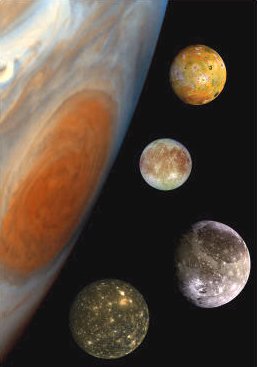Planets of the summer sky
For most of this summer, the planet Jupiter is the king of our evening sky. Named for the Romans' king of the gods, the largest planet in our solar system shines strong and steady, a bright white beacon in the western sky after dark. With Venus lost in the glare of sunrise, Jupiter is the brightest body in the sky right now after the Sun and Moon.
With binoculars you can easily see four of the more than 60 moons of Jupiter. Lo, Europa, Ganymede, and Callisto hover near the planet in varying configurations. Their names, too, are derived from classic mythology, each of them having been loved by the king of the gods in his Greek form Zeus.
Europa was apparently a Cretan lunar goddess in her own right before being assimilated into Greek mythology.
Callisto may be better known to us as the beset woman turned into a bear turned into the constellation Ursa Major, the Big Dipper.
Ganymede, a beautiful young man, was transported to Olympus to become the cupbearer to the gods and goddesses.
Poor Io endured many trials during her relationship with Zeus, not the least of which was being turned into a white cow to escape his wife Hera's jealous eye (Hera obviously had good reason to be suspicious).
For sky-watchers, these four satellites are known as the Galilean moons, so called because they were first discovered by Galileo himself as he was playing with his new invention the astronomical telescope in 1610. Of these, Ganymede is our solar system's largest planetary moon, even larger than Mercury and the now sub-planet Pluto. With a telescope, Jupiter's Great Red Spot, in addition to other atmospheric turbulence, may be visible, as well.
The next-brightest planet visible this summer is Mars, which rises in the southeast shortly after sunset and can be seen through the night. While fading now from the magnitude it reached this spring, this distinctive red planet is still fairly easy to pick out in the summer sky. Despite Mars being much smaller in actual size than Jupiter, because it is so much closer to Earth, the two planets seem to us relatively close in size and brightness when observed with the naked eye.
Being the color of blood, Mars was aptly named for the Roman god of war. Mars's two moons, Phobos and Deimos, are named for Fear and Panic, the god's dogs of war.
What's especially fun about observing Mars this summer is the planet's proximity to Saturn, just to its left in the southeastern sky. While not as bright, its fixed glow reveals that it too is a planet, not a twinkling star. The second-largest planet is of course best known for its rings. While the rings are not visible with binoculars, a small telescope should help you see what is considered to be one of the most beautiful spectacles of our solar system (even my little birding scope was up to the task). This summer the rings' north face will be tilted slightly toward us and thus more visible than when they are edge on.
Saturn, Mars, and the red supergiant Antares ("anti-Ares" or "rival of Ares/Mars") in the constellation Scorpio currently form a sort of triangle together in the night sky, with Antares being the lowest and least bright point of the three. The brightest star in Scorpio, Antares is also referred to as "the heart of the Scorpion."
Mars and Saturn will continue to be on show near one another throughout the summer, with Saturn moving increasingly westward and closer to Mars as the season progresses. The two planets come into conjunction (i.e. are right next to each other) on August 24.
In mythology the ancient god Saturn (the Greek god Cronus) was associated with prosperity, agriculture, and time. He was the father of Jupiter, Pluto, Neptune, and others—so in that sense, might really be thought of as the father of the planets (with his father Uranus being the grandfather). Visible through binoculars, the planet Saturn's color, often described as honey gold or lemony, sustains this association with the harvest.
Saturn belonged to the older group of deities referred to as the Titans, so it is thus appropriate that the planet's largest moon (of many) is named Titan. If Titan's cloud cover were considered in measuring its size, it would surpass Ganymede as the largest moon in our solar system.
One of the pleasures of a Maine summer is the clarity of our night sky. Pinpointing these three bright planets—these veritable gods of our solar system—amid the dazzling array of stars livens up a summer evening. For some, pondering the presence of other planets besides Earth gives us pause, good food for thought. And for others, the classic myths and stories of the planets' namesakes that have been passed down for centuries can be just as fascinating as the astronomy.
Kristen Lindquist is an amateur naturalist and published poet who lives in her hometown of Camden.
More Meditations
Northern Sky basics with the Big Dipper
Early Christmas morning: Look up! A full moon, and Orion bright in the sky
Spring peepers in autumn: Why are they still talking
Fall migration on Monhegan and the Yellow-rumped Warbler
Event Date
Address
United States






























